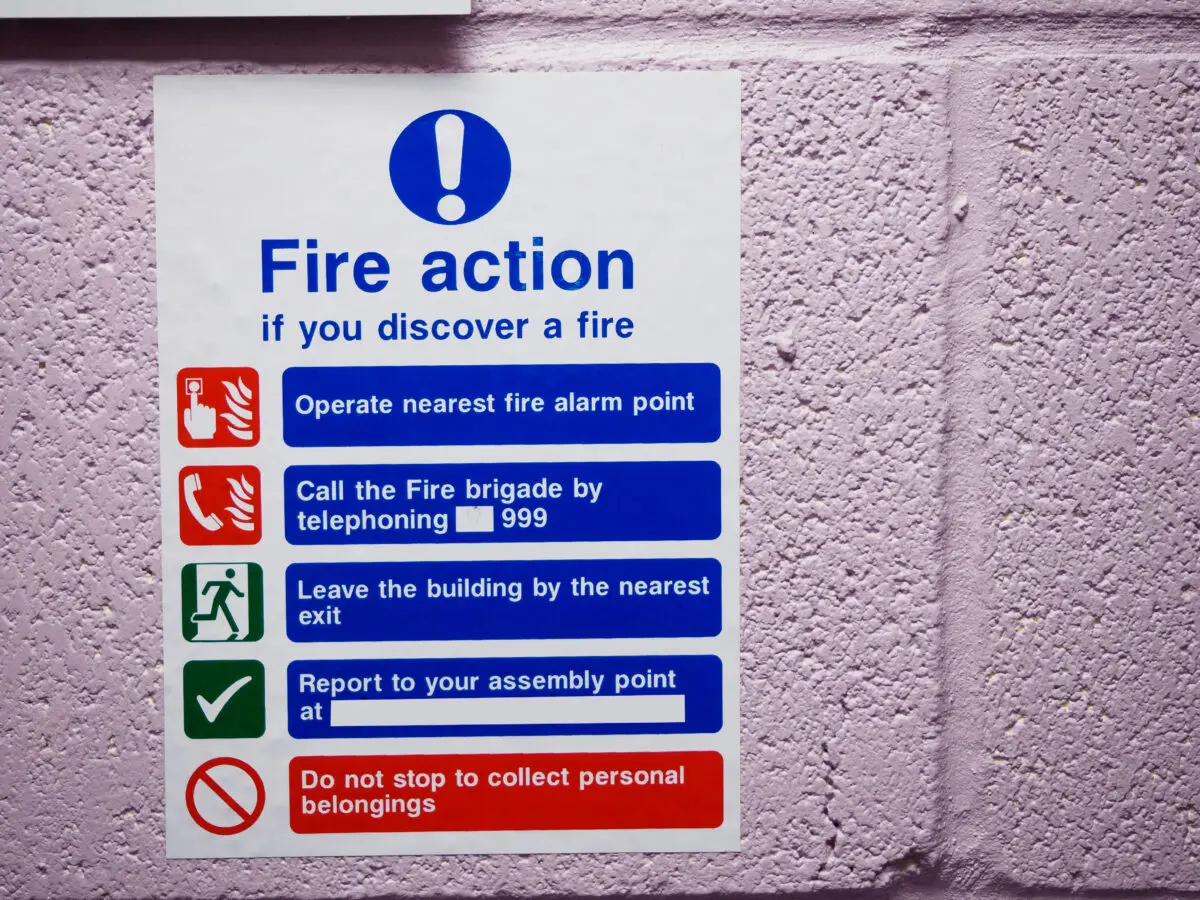Darren Bagnall from Block in a Box, explains where fire signs should be placed by law, and why regular checks are so important.
Fire safety signs are a legal requirement in most residential buildings, but they can be overlooked. Unlike alarms and extinguishers, signs are more passive. They sit on walls or doors and are easy to forget – but when a fire breaks out, clear and correct signage can help save lives.
Residents’ Management Companies (RMC) and property managers have a duty to ensure that all safety measures, including signage, are up to standard.
Why Fire Safety Signs Matter
Clear signs support evacuation plans and reduce panic. When a fire alarm sounds, people need to act fast. If the building fills with smoke, visibility drops and people can go into panic mode. In these moments, people rely on clear, legible fire signs to guide them to exits and equipment. For buildings with vulnerable or elderly residents, this becomes even more critical.
Proper signage also helps the emergency services to locate key features such as riser cupboards, firefighting lifts and dry risers. Anything that speeds up response times is helpful.
What the Law Says
In England, the Regulatory Reform (Fire Safety) Order 2005 places the duty of fire safety on the “responsible person”. In many leasehold blocks, this is the RMC, freeholder, or managing agent.
The law states that the responsible person must:
- Ensure fire safety signs are provided where necessary
- Make sure signs are clearly visible and legible
- Maintain signs in good working order
Additionally, for buildings over 11 metres in height, the Fire Safety (England) Regulations 2022 introduced further requirements, including duties to check fire doors and maintain information for fire and rescue services. Correct signage supports these duties.
The Health and Safety (Safety Signs and Signals) Regulations 1996 also apply. These specify colours and shapes for different types of signs, ensuring consistency across all buildings.
Different Types of Fire Safety Signs
There are four main types of signs you need to consider:
- Fire Exit and Escape Route Signs
These are green signs that indicate the quickest and safest way out of the building. They should include directional arrows and be placed above doors and in corridors and stairwells. They must be clearly visible from all directions of travel.
- Fire Action Notices
These signs give instructions. They often include details such as whether to stay put or evacuate, who to contact, and where the assembly point is located. They should be placed near exits, lifts and in entrance lobbies.
- Fire Equipment Signs
These are red signs that show the location of fire extinguishers, hose reels and fire alarm call points. They must be placed directly above or beside the relevant equipment.
- Warning and Prohibition Signs
These include yellow warning signs (e.g. “Fire risk area”) and red prohibition signs (e.g. “Do not use lift in case of fire”). These help to reinforce safe behaviour and highlight hazards.
All signs should use clear symbols and text. In most cases, pictograms must be included so that non-English speakers and those with reading difficulties can understand the message.
Where Should Signs Be Placed?
Correct placement is key. Signs should be positioned at consistent heights and must not be blocked by furniture or decorations. Considerations should be given to the following locations:
- Above all final exits leading to a place of safety
- At every change in direction along escape routes
- At all fire doors, showing they must be kept shut
- Next to each fire alarm call point and extinguisher
- In communal entrance halls, next to lifts, and near stairwells
Signs must be visible in both normal and emergency lighting. In larger buildings, or where lighting might fail, photoluminescent signs (which glow in the dark) are often recommended.
Accessibility Considerations
Fire signage must be inclusive. The Equality Act 2010 requires service providers and housing managers to take reasonable steps to ensure that all residents, including those with disabilities, can safely evacuate.
To meet this duty, consider:
- Using large font sizes and high contrast colours
- Placing signs at eye level for wheelchair users
- Including braille or tactile elements on key signs
- Ensuring that signs are not placed behind glass where glare may cause problems
In buildings with residents who have hearing or sight loss, you may need to combine signs with other alerts, such as visual alarms or vibrating pads linked to the fire system.
Maintenance and Routine Checks
Signs must be checked regularly and replaced if damaged, faded, missing or blocked. As part of your fire safety routine, ensure that:
- All required signs are present and in the correct places
- Signs are clean, legible and firmly fixed to surfaces
- Escape route signs point the right way (especially after layout changes)
- Temporary signs used during works are removed promptly
- Photoluminescent signs still glow in low light conditions
Signs should be reviewed at least annually, or more often if refurbishment or redecoration has taken place.
Fire Drills and Signage in Practice
A fire drill is the best way to test if signage is doing its job. Even in residential blocks where full evacuations are not always advised, a simulated walkthrough can help management teams and residents understand evacuation routes.
During a drill or review, ask yourself:
- Can you follow the route without confusion?
- Are exit signs visible in poor lighting or smoky conditions?
- Are instructions clear and easy to follow?
- Can a visitor or new resident understand the signage?
Gather feedback after the drill – residents may spot missing signs or confusing layouts that you have missed.
Simple Signage Checklist for RMCs
Use this list to carry out a quick signage audit:
- Are all fire exit routes clearly marked with green directional signs?
- Are fire doors labelled and free from obstructions?
- Are fire extinguishers and call points marked with red signs?
- Is there a fire action notice at the building entrance and by lifts?
- Are warning signs used where needed (e.g. riser cupboards)?
- Are signs clear, undamaged, and well-positioned?
- Are signs suitable for residents with visual impairments?
- Are your signs included in the fire risk assessment records?
If the answer to any of these is “no”, it’s time to act.
In Summary
In an emergency, fire safety signage provides essential guidance when people are panicked and visibility is poor. For RMCs and property managers, checking and updating signage is a simple but powerful step towards protecting life and property.
Even small improvements can make a big difference. Make sure your signs are where they need to be, easy to read, accessible to all, and up to date with the building’s current layout and safety strategy.
For fire information posters, our partners 4site Consulting can help! Visit our website for more information or to request a quote.







Leave A Comment